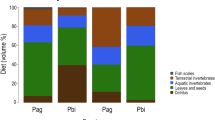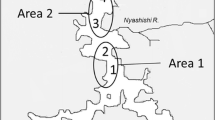Abstract
Understanding how omnivorous consumers are affected by their resources and how this is expressed through the food chain is a fundamental issue in ecology. We used stable isotope analysis of archived scales of two pelagic single-chain omnivorous fish species, bighead carp (Hypophthalmichthys nobilis) and silver carp (H. molitrix), to reconstruct historical trophic interactions patterns along a gradient of resources. We found that, although bighead carp and silver carp utilize the similar resources from the pelagic food chain, they can coexist and persist not only by regulating their trophic position and trophic dissimilarity, but also by regulating trophic niche width. Omnivorous fish often exhibit flexible foraging strategies, which is closely related to the availability of ecologic context. We found a positive relationship between trophic dissimilarity and zooplankton density, which may indicate that the competitive interactions induce strong top-down effects on zooplankton, and/or that high zooplankton availability release the between-population trophic interaction through bottom-up effect. The trophic niche width of bighead carp was positively related with zooplankton availability, probably reflecting that the niche of an omnivore at a higher trophic position is more sensitive to high quality resources. Our results indicate how different aspects of the trophic partitioning of coexisting omnivores may be regulated by different ecological contexts. These alternatives are not mutually exclusive and further theoretical work should include both these mechanisms to re-evaluate the effects of omnivory on food web properties.





Similar content being viewed by others
References
Bearhop S, Adams CE, Waldron S, Fuller RA, MacLeod H (2004) Determining trophic niche width: a novel approach using stable isotope analysis. J Anim Ecol 73:1007–1012
Brett MT, Goldman CR (1997) Consumer versus resource control in freshwater pelagic food webs. Science 275:384–386
Bunn SE, Loneragan NR, Kempster MA (1995) Effects of acid washing on stable isotope ratios of C and N in penaeid shrimp and seagrass: implications for food-web studies using multiple stable isotopes. Limnol Oceanogr 40:622–625
Carpenter SR, Kitchell JF (1996) The trophic cascade in lakes. Cambridge University Press
Carpenter SR, Kitchell JF, Cottingham KL, Schindler DE, Christense DL, Post DM, Voichick N (1996) Chlorophyll variability, nutrient input, and grazing: evidence from whole-lake experiments. Ecology 77:725–735
Cooke SL, Hill WR, Meyer KP (2009) Feeding at different plankton densities alters invasive bighead carp (Hypophthalmichthys nobilis) growth and zooplankton species composition. Hydrobiologia 625:185–193
Corrigan LJ, Winfield IJ, Hoelzel AR, Lucas MC (2011) Dietary plasticity in Arctic charr (Salvelinus alpinus) in response to long-term environmental change. Ecol Freshw Fish 20:5–13. doi:10.1111/j.1600-0633.2010.00446.x
Diehl S (1993) Relative consumer sizes and the strengths of direct and indirect interactions in omnivorous feeding relationships. Oikos 68(1):151–157
Estep MLF, Vigg S (1985) Stable carbon and nitrogen isotope tracers of trophic dynamics in natural populations and fisheries of the Lahontan Lake system, Nevada. Can J Fish Aquat Sci 42:1712–1719
Fincel M, Vandehey J, Chipps S (2012) Non-lethal sampling of walleye for stable isotope analysis: a comparison of three tissues. Fish Manag Ecol 19:283–292
García-Berthou E, Alcaraz C, Pou-Rovira Q, Zamora L, Coenders G, Feo C (2005) Introduction pathways and establishment rates of invasive aquatic species in Europe. Can J Fish Aquat Sci 62:453–463
Gerdeaux D, Perga ME (2006) Changes in whitefish scales δ13C during eutrophication and reoligotrophication of Subalpine Lakes. Limnol Oceanogr 51:772–780
Gregersen F, Aass P (2006) Long-term variation in diet of Arctic char, Salvelinusalpinus, and brown trout, Salmo trutta effects of changes in fish density and food availability. Fish Manag Ecol 243–250
Gu B, Schell DM, Huang X, Yie F (1996) Stable isotope evidence for dietary overlap between two planktivorous fishes in aquaculture ponds. Can J Fish Aquat Sci 53:2814–2818
Holt RD, Polis GA (1997) A theoretical framework for intraguild predation. Am Nat 745–764
Hutchinson GE (1957) Concluding remarks. Cold Spring Harbor Symp Quant Biol 22:415–427
Jackson AL, Inger R, Parnell AC, Bearhop S (2011) Comparing isotopic niche widths among and within communities: SIBER—Stable Isotope Bayesian Ellipses in R. J Anim Ecol 80:595–602
Jackson MC, Donohue I, Jackson AL, Britton JR, Harper DM, Grey J (2012) Population-level metrics of trophic structure based on stable isotopes and their application to invasion ecology. PLoS One 7:e31757
Kelly MH, Hagar WG, Jardine TD, Cunjak RA (2006) Nonlethal sampling of sunfish and slimy sculpin for stable isotope analysis: how scale and fin tissue compare with muscle tissue. N Am J Fish Manage 26:921–925
Kolar CS, Chapman DC, Courtenay Jr WR, Housel CM, Williams JD, Jennings DP (2005) Asian carps of the genus Hypophthalmichthys (Pisces, Cyprinidae): a biological synopsis and environmental risk assessment. Report to the US Fish and Wildlife Service
Layman CA, Arrington DA, Montaña CG, Post DM (2007) Can stable isotope ratios provide for community-wide measures of trophic structure? Ecology 88:42–48
Lei A, Hu Z, Wang J, Shi Z, Tam FN (2005) Structure of the phytoplankton community and its relationship to water quality in Donghu Lake, Wuhan, China. J Integr Plant Biol 47:27–37
Liu J (1984) Lakes of the middle and lower basins of the Chang Jiang (China). Lakes Reserv 331
Loeuille N, Loreau M (2004) Nutrient enrichment and food chains: can evolution buffer top–down control? Theor Popul Biol 65:285–298
Lu M, Xie P, Tang H, Shao Z, Xie L (2002) Experimental study of trophic cascade effect of silver carp (Hypophthalmichthys molitrixon) in a subtropical lake, Lake Donghu: on plankton community and underlying mechanisms of changes of crustacean community. Hydrobiologia 487:19–31
Macarthur R, Levins R (1967) The limiting similarity, convergence, and divergence of coexisting species. Am Nat 101:377–385
McCann K, Hastings A (1997) Re-evaluating the omnivory–stability relationship in food webs. Proc R Soc Lond B Biol Sci 264:1249–1254
Minagawa M, Wada E (1984) Stepwise enrichment of 15N along food chains: further evidence and the relation between δ15N and animal age. Geochim Cosmochim Ac 48:1135–1140
Neutel AM, Heesterbeek JA, De Ruiter PC (2002) Stability in real food webs: weak links in long loops. Science 296(5570):1120–1123
Newsome SD, del Rio CM, Bearhop S, Phillips DL (2007) A niche for isotopic ecology. Front Ecol Environ 5:429–436. doi:10.1890/060150.01
Pace ML, Cole JJ, Carpenter SR, Kitchell JF (1999) Trophic cascades revealed in diverse ecosystems. Trends Ecol Evol 14:483–488
Paine RT (1980) Food webs: linkage, interaction strength and community infrastructure. J Anim Ecol 49:667–685
Parnell A, Jackson A (2013) siar: Stable Isotope Analysis in R. R package version 42. http://CRANR-project.org/package=siar
Perga ME, Gerdeaux D (2003) Using the δ13C and δ15N of whitefish scales for retrospective ecological studies: changes in isotope signatures during the restoration of Lake Geneva, 1980–2001. J Fish Biol 63:1197–1207
Pimm S, Lawton J (1978) On feeding on more than one trophic level. Nature 275:542–544
Pinnegar JK, Polunin NVC (1999) Differential fractionation of δ13C and δ15N among fish tissues: implications for the study of trophic interactions. Funct Ecol 225–231
Polis GA (1991) Complex trophic interactions in deserts: an empirical critique of food-web theory. Am Nat 138(1):123–155
Post DM (2002) Using stable isotopes to estimate trophic position: models, methods, and assumptions. Ecology 83:703–718. doi:10.2307/3071875
Pruell RJ, Taplin BK, Cicchelli K (2003) Stable isotope ratios in archived striped bass scales suggest changes in trophic structure. Fish Manag Ecol 10:329–336
R Development Core Team (2013) R: A language and environment for statistical computing. R Foundation for Statistical Computing, Vienna, Austria. http://R-project.org/
Rosenzweig ML (1971) Paradox of enrichment: destabilization of exploitation ecosystems in ecological time. Science 171:385–387
Strong DR (1992) Are trophic cascades all wet? Differentiation and donor-control in speciose ecosystems. Ecology 73:747–754
Syväranta J, Lensu A, Marjomäki TJ, Oksanen S, Jones RI (2013) An empirical evaluation of the utility of convex hull and standard ellipse areas for assessing population niche widths from stable isotope data. PLoS One 8:e56094
Thompson RM, Hemberg M, Starzomski BM, Shurin JB (2007) Trophic levels and trophic tangles: the prevalence of omnivory in real food webs. Ecology 88:612–617
Vadeboncoeur Y, McCann KS, Vander Zanden MJ, Rasmussen JB (2005) Effects of multi-chain omnivory on the strength of trophic control in lakes. Ecosystems 8:682–693
Vander Zanden MJ, Cabana G, Rasmussen JB (1997) Comparing trophic position of freshwater fish calculated using stable nitrogen isotope ratios (δ15N) and literature dietary data. Can J Fish Aqat Sci 54:1142–1158
Vandermeera J (2006) Omnivory and the stability of food webs. J Theor Biol 238:497–504
Wainright SC, Fogarty MJ, Greenfield RC, Fry B (1993) Long-term changes in the Georges Bank food web: trends in stable isotopic compositions of fish scales. Mar Biol 115:481–493
Winemiller KO (1996) Factors driving temporal and spatial variation in aquatic floodplain food webs. Food webs. Springer, USA
Xie P (2001) Gut contents of bighead carp (Aristichthys nobilis) and the processing and digestion of algal cells in the alimentary canal. Aquaculture 195:149–161
Xie P, Liu J (2001) Practical success of biomanipulation using filter fish to control cyan bacteria blooms: a synthesis of decades of research and application in a subtropical hypereutrophic lake. Sci World J 1:337–356
Xie L, Xie P (2002) Long-term (1956–1999) dynamics of phosphorus in a shallow, subtropical Chinese lake with the possible effects of cyanobacterial blooms. Water Res 36:343–349
Xu J, Xie P (2004) Studies on the food web structure of Lake Donghu using stable carbon and nitrogen isotope ratios. J Freshw Ecol 19:645–650
Xu J, Wen Z, Gong Z, Zhang M, Xie P, Hansson L-A (2012) Seasonal trophic niche shift and cascading effect of a generalist predator fish. PLoS One. doi:10.1371/journal.pone.0049691
Xu J, Wen Z, Ke Z, Zhang M, Zhang M, Guo N, Hansson L-A, Xie P (2014) Contrasting energy pathways at the community-level as a consequence from regime shifts. Oecologia. doi:10.1007/s00442-013-2878-2
Xu J, Su G, Xiong Y, Akasaka M, García Molinos J, S-i Matsuzaki, Zhang M (2015) Complimentary analysis of metacommunity nestedness and diversity partitioning highlights the need for a holistic conservation strategy for highland lake fish assemblages. Global Ecol Conserv 3:288–296. doi:10.1016/j.gecco.2014.12.004
Xu J, Zhang H, Cai Y, García Molinos J, Zhang M (2016) Optional response to habitat linkage of local fish diversity and mean trophic level. Limnol Oceanogr. doi:10.1002/lno.10313
Yang Y, Huang X, Liu J (1998) Long-term changes in crustacean zooplankton and water quality in a shallow, eutrophic Chinese lake densely stocked with fish. Hydrobiologia 391:193–201
Yodzis P (1984) How rare is omnivory? Ecology 65:321–323
Zhang X, Xie P, Huang X (2008) A review of nontraditional biomanipulation. Sci World J 8:1184–1196
Zhang H, Zhang H, Wu G, Zhang P, Xu J (2013a) Trophic fingerprint of fish communities in subtropical floodplain lakes. Ecol Freshw Fish. doi:10.1111/eff.12022
Zhang P, Tang H, Gong Z, Xie P, Xu J (2013b) Phytoplankton abundance constrains planktonic energy subsidy to benthic food web. J Ecosyst Ecogr. doi:10.4172/2157-7625.1000139
Zhou Q, Xie P, Xu J, Ke Z, Guo L (2009a) Growth and food availability of silver and bighead carps: evidence from stable isotope and gut content analysis. Aquac Res 40:1616–1625
Zhou Q, Xie P, Xu J, Ke ZX, Guo LG, Cao T (2009b) Seasonal variations in stable isotope ratios of two biomanipulation fishes and seston in a large pen culture in hypereutrophic Meiliang Bay, Lake Taihu. Ecol Eng 35:1603–1609
Acknowledgments
We thank the members of the Donghu Experimental Station of Lake Ecosystem, Chinese Ecological Research Network, for their field and laboratory assistance. This research was supported by the National Natural Science Foundation of China (Grant Nos. 31370473 and 31170439). There are no actual or potential competing financial interests. The funders had no role in the study design, data collection and analysis, decision to publish, or preparation of the manuscript. We are very grateful to Prof. Roger Jones and anonymous reviewers for their valuable comments on the early version of the manuscript.
Author information
Authors and Affiliations
Corresponding author
About this article
Cite this article
Yao, X., Huang, G., Xie, P. et al. Trophic niche differences between coexisting omnivores silver carp and bighead carp in a pelagic food web. Ecol Res 31, 831–839 (2016). https://doi.org/10.1007/s11284-016-1393-4
Received:
Accepted:
Published:
Issue Date:
DOI: https://doi.org/10.1007/s11284-016-1393-4




